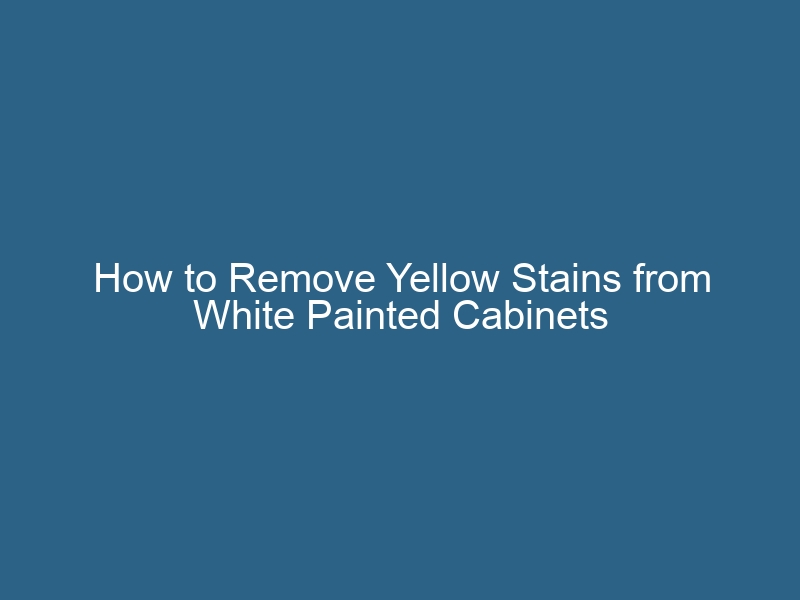Quck answer
White painted cabinets can often become yellowed over time due to various factors such as sunlight exposure, smoke, and cooking grease. To clean yellowed white painted cabinets, follow these steps:
1. Start by removing all items from the cabinets and wiping down the surfaces with a soft cloth to remove loose dirt and dust.
2. Mix a solution of equal parts vinegar and water. Vinegar is a natural cleaner that can help remove yellowing stains.
3. Dip a sponge or cloth into the vinegar solution and wring out the excess liquid. Gently scrub the cabinets, focusing on the yellowed areas.
4. For stubborn stains or grime, make a paste using baking soda and water. Apply the paste to the stains and let it sit for a few minutes before scrubbing with a sponge or cloth.
5. Rinse the cabinets with clean water and wipe them dry with a clean cloth.
6. Finally, apply a coat of white paint or a clear sealer to restore the cabinets’ brightness and protect them from future yellowing.
Regular cleaning and maintenance can help prevent yellowing of white painted cabinets.
Have you ever experienced this? One morning, you notice that the sunlight is revealing the yellow stains on your once-white and shiny kitchen cabinets. You’re not alone in this, and it’s not just white cabinets that turn yellow over time; they are just the most noticeable. Fortunately, with some effort and the right approach, you can significantly improve the appearance of your yellowing kitchen cabinets.
Is There Hope for Restoration?
Often, the discoloration of kitchen cabinets is caused by grease, dirt, and aging. However, certain cabinet finishes, such as vinyl, can also react to sunlight and become discolored. These cabinets should not be exposed to direct sunlight for extended periods and are generally not covered by warranty for color-fastness. To prevent this, these kitchens should only have indirect sunlight, with UV filtering window film, blinds, or sheer curtains. Unfortunately, in cases of sun damage, the yellowing may be permanent.
To find out if your cabinets can be restored, try cleaning a small area using the recommended method below. If there is no improvement, the yellow stains may be permanent. Additionally, some white cabinet materials, like thermofoil, have a tendency to yellow and deteriorate over time. This is due to the nature of the material and cannot be fixed.
Old veneer and varnish can also turn yellow, while alkyd-painted cabinets may yellow if they are not in a well-lit area. Sometimes, the yellowing is simply a result of using defective products. If cleaning does not effectively remove the stains, you may want to consider other cosmetic options, such as painting with a durable product like acrylic or enamel paint.
Preparing Your Kitchen
When cleaning your kitchen cabinets, keep in mind that a significant amount of cleaning solution will drip onto your countertops and floors. This is a great opportunity to thoroughly clean those surfaces as well. Prepare by clearing off the counters to create a clean work area. You will be surprised at how quickly and effectively you can clean without clutter on the counters.
The Most Effective Method for Cleaning White Kitchen Cabinets
Create a solution by mixing ¼ cup of baking soda, 4 cups of white vinegar, and 8 cups of warm water in a 2-gallon bucket. (Do not substitute vinegar with ammonia, as it can damage certain cabinet finishes.) Mix the solution well and use clean cloths or sponges to scrub the cabinet doors. This may require some effort, and you may need to repeat the process more than once. Rinse with clean water and dry with a cloth.
If stubborn stains persist, you can directly apply baking soda to your sponge or cloth and gently scrub. Avoid using bleach or abrasive cleaners, as they can damage the cabinet finish. For very stubborn stains, you can test products like Goo Gone or OOPS! in an inconspicuous area to see if they are safe to use on your cabinets.
Some homeowners swear by using Magic Erasers to remove yellow stains. However, be cautious as these products can potentially damage thermofoil cabinet fronts and other materials. Always test them in an inconspicuous spot first.
Prevention:
Maintaining Cleanliness in the Kitchen
While many people believe that opening a window while cooking is sufficient ventilation for the kitchen, research indicates that most individuals do not ventilate properly, resulting in poor air quality due to airborne grease and other particles. The grease becomes airborne and covers everything in the kitchen, even surfaces several feet away from the stove. Instead of appearing oily, it creates a yellow and sticky surface, which is actually grease.
It is important to always use a range hood for ventilation and turn it on before any smoke is produced. Regularly wiping down all cabinets and ensuring proper ventilation while cooking will contribute to a sparkling clean kitchen.


